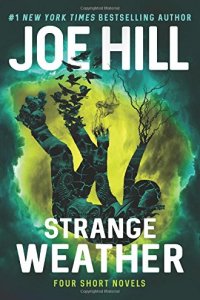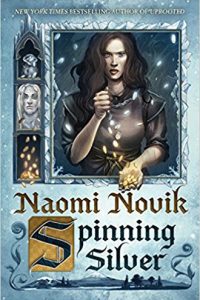Paul Di Filippo reviews Annex by Rich Larson
Annex, Rich Larson (Orbit 978-0-316-41654-2, $15.99, 368pp, trade paperback) July 2018
 I’ve been enjoying the stories of Rich Larson for a couple of years now, amazed at his rate of production and polished skills. (Over a hundred tales sold since his debut in 2011, with several taken for best-of compilations.) So his first novel is a book greatly anticipated, and, happily, it lives up to the measure and promise of the stories. Although let me set, however pitilessly, a gold standard–a resonant gold standard, given the allied theme of Larson’s book, a world undone by new forces of otherness–which Annex does not quite meet. And that gold standard is John Varley. Same arc to the career: a wave of knockout stories, followed by a killer first book, The Ophiuchi Hotline. But Annex–the first in what is to be dubbed The Violet Wars–is simply not as rich nor as complex nor as ambitious as Varley’s novel-length debut. It’s good, but it’s not earth-shattering. But then again, how many Varleys do we get in a lifetime?
I’ve been enjoying the stories of Rich Larson for a couple of years now, amazed at his rate of production and polished skills. (Over a hundred tales sold since his debut in 2011, with several taken for best-of compilations.) So his first novel is a book greatly anticipated, and, happily, it lives up to the measure and promise of the stories. Although let me set, however pitilessly, a gold standard–a resonant gold standard, given the allied theme of Larson’s book, a world undone by new forces of otherness–which Annex does not quite meet. And that gold standard is John Varley. Same arc to the career: a wave of knockout stories, followed by a killer first book, The Ophiuchi Hotline. But Annex–the first in what is to be dubbed The Violet Wars–is simply not as rich nor as complex nor as ambitious as Varley’s novel-length debut. It’s good, but it’s not earth-shattering. But then again, how many Varleys do we get in a lifetime?
The book is an invasion-of-Earth novel, a depiction of a shattered civilization, all rubble and desperation. As these things go, on the continuum of naturalistic to surreal, it’s about midway, rather like Will McIntosh’s Defenders as opposed to his Faller. It’s certainly not as gonzo as VanderMeer’s Borne. If I can ring in a series that is not alien invasion, but fits into the dog-eat-dog, world-turned-upside-down ambiance, I’d cite Paolo Bacigalupi’s Ship Breaker sequence as well.
We are in a city cut off from the rest of the world by impenetrable barriers. Above it, in the clouded skies, hangs the alien mothership. On the ground, various instruments of the aliens–pods, whirlybirds, othermothers–stalk the remaining free humans, who are all children of various ages, up through late adolescence. The adults have all been “clamped.” Neural shunts force them to inhabit a VR dream world, barely able to maintain their physical existence. As for the kids, they have all been implanted with “Parasites,” gut-embedded organisms whose purpose are obscure. (The reveal for the nature of the Parasites is well done and critical.) After this treatment, the kids are stashed in warehouses–except for the few who have managed to get free. Our narrative focus will embrace two such: Bo and Violet.
Bo is only eleven, and manages to escape captivity through deploying arcane powers granted by his Parasite. Besides mere survival, his main drive is to rescue his sister Lia, still held by the aliens. Violet, older, is a member of the Lost Boys, a troop run by the dominant fellow named Wyatt. Born male, Violet has used the occasion of the apocalypse to assert the female identity she was not allowed to represent by her parents. It’s the only silver lining in the chaos. Her transexual nature plays a significant but not super dominant part in the tale, and in fact she comes to be roundly characterized by a host of other bold actions beyond simple gender issues.
When Bo, with his strange powers, hooks up with Violet and the Lost Boys, Wyatt is moved to ramp up his plans for revenge on the aliens. Incredibly, through insane acts of bravery, pure luck, and the help of a second, rival alien named Gloom, the Lost Boys manage to take the battle from their besieged turf into the world of the invaders. By the novel’s end, certain gains have been made, but the territory ahead offers plenty of challenges for Larson’s subsequent explorations.
As I said a little while ago in my review of Harlan Ellison’s Blood’s a Rover, the trope of brutal youths struggling in a post-catastrophe world was one of the motifs Ellison cemented in place for the genre, and the feel of the Lost Boys dynamics recalls Ellison’s template. Additionally, with all the grownups out of the picture, I kept flashing on the famous Star Trek episode Miri, in which the Enterprise encountered a planet where a band of kids held sway under the leadership of Michael J. Pollard. In fact, given Wyatt’s bug-eyed suave Machiavellianism, I started picturing him as Pollard throughout. Not a bad congruence, I think.
Larson crams a superabundance of action into just a few days of realtime for his characters. The pacing is nonstop, and just when you think a certain pattern has assumed permanence, he fruitfully upsets it. For instance, as a tiny spoiler: after seeming like an inseparable Batman and Robin of the Lost Boys, Wyatt and Violet have a vicious falling-out that contours the rest of the action. This daring to pull the rug out from under the expectations of the reader is admirable.
Larson has a cinematic eye for depicting the disturbing shadows and tumbled vistas of the wreckage of his world, and while his scenario never attains the surreal proportions of something like Disch’s The Genocides or Tenn’s Of Men and Monsters, there are plenty of frissons to go around. For instance, when Violet returns to her family home, where her mother and father mime the actions of their forced hallucinations.
She put her shaking hand on the doorknob and turned it. Inside was pitch dark. She didn’t have her flashlight, so she picked her way carefully through the entryway, kicking aside a pair of old shoes. As her eyes adjusted she saw her mom washing dishes in the dark, or at least going through the motions, head bent over the sink, scrubbing a dry plate with a dry sponge. It was sad and stupid and put another sob in Violet’s throat. She took a step forward, unsure what she wanted. To rip the plate out of her mom’s hands and smash it over her head. To wrap around her from behind and hug her and tell her everything that had happened.
This blend of the bizarre and the pathetic, of tugged heartstrings and angry outbursts, of hope nearly extinct and fatalism almost dominant is the signature of Larson’s book, and a bold autograph it is.
 While you are here, please take a moment to support Locus with a one-time or recurring donation. We rely on reader donations to keep the magazine and site going, and would like to keep the site paywall free, but WE NEED YOUR FINANCIAL SUPPORT to continue quality coverage of the science fiction and fantasy field.
While you are here, please take a moment to support Locus with a one-time or recurring donation. We rely on reader donations to keep the magazine and site going, and would like to keep the site paywall free, but WE NEED YOUR FINANCIAL SUPPORT to continue quality coverage of the science fiction and fantasy field.






